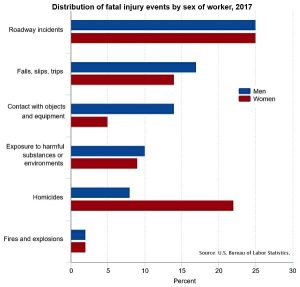Last May, a shooting by an employee at Virginia Beach’s Department of Utilities marked one of the worst instances of workplace violence in the US in more than a decade. Unfortunately, workplace violence isn’t all that rare. In 2016, there were 500 workplace homicides, accounting for 10% of all fatal occupational injuries. Even more shocking, workplace violence is the second leading cause of death for women in the workplace.
 A safe and secure workplace is crucial to productivity, by one estimate workplace violence costs $121 billion in annual losses. Millions of Americans report being victims of workplace violence, which Occupational Safety and Health Organization (OSHA) defines as any act of physical violence, harassment, intimidation, or other threatening behavior that occurs at a worksite, every year. It includes both physical and verbal abuse and isn’t always easy to spot and handle.
A safe and secure workplace is crucial to productivity, by one estimate workplace violence costs $121 billion in annual losses. Millions of Americans report being victims of workplace violence, which Occupational Safety and Health Organization (OSHA) defines as any act of physical violence, harassment, intimidation, or other threatening behavior that occurs at a worksite, every year. It includes both physical and verbal abuse and isn’t always easy to spot and handle.
Who is most at risk? According to OSHA, those who exchange money with customers, delivery drivers, healthcare professionals, public service workers, customer service agents, and those who work alone or in small groups.
Under the Occupational Safety and Health Act of 1970, employers have a responsibility to maintain a safe and healthy workplace for their employees. This includes enforcing standards of behavior and providing training and assistance to employees. The first step to preventing workplace violence is staying informed and attentive to workplace dynamics.
Below are some steps to take toward ensuring a safer workplace.
Warning signs
In an ideal world, workplace violence can be prevented through recognizing and reporting warning signs, so it is important to educate your employees on what these are. Below are some of the tell-tale signs the National Safety Council advises to look out for:
- Excessive use of alcohol or drugs
- Unexplained absences, a sudden change in behavior, or decline in job performance
- Depression, withdrawal, or suicidal comments
- Resistance to changes at work or persistent complaining about unfair treatment
- Disregard or violation of company policies
- Emotional responses to criticism
- Paranoia
Zero tolerance policy
OSHA says establishing a zero-tolerance for violence policy is one of the best protections an employer can offer its employees. It sends a clear message that violence has no place in your company and all threats or instances of workplace violence will be documented and investigated.
When establishing a policy, include definitions of prohibited behaviors such as workplace violence, harassment, threats, etc, utilizing definitions your company will enforce. It should then list exactly how employees should report inappropriate behavior and a timeframe for doing so. State what disciplinary actions violators should expect to face. To further demonstrate that your policy is there for the employees, companies should also describe how they process and investigate reports.
Encourage speaking up
Having a process for reporting incidents and threats is only effective if employees feel comfortable speaking up. In a 2015 study, 23% of survey respondents working in the healthcare field said that they did not report violence that they had experienced in the workplace because of fear of repercussions or lack of support from supervisors and coworkers.
Speaking up and reporting incidents is paramount for a safer workplace. It enables employers to keep records of incidents, evaluate situations properly, and respond appropriately. Encourage employees to report suspicious, violent, or intimidating behavior by reassuring that all reports will be taken seriously and their safety matters. If your process allows anonymous complaints, let your employees know, and encourage managers to check-in, especially if their team is at higher-risk.
Be prepared
A recent survey found 30% of respondents are unaware of their employers’ emergency preparedness plans for the most common types of workplace emergencies, such as violence, severe weather, company outages, and even cyber-attacks.
Consider establishing policies and procedures for emergencies. While it doesn’t eliminate the threats, it does demonstrate thoughtfulness and provide an extra sense of security for your employees. Once created, administer regular training to reinforce the plan, as well as how to report suspicious behavior. Take it a step further and work with marketing and create an easy to follow 1-pager or bookmark with the plan’s details as well as information for the nearest hospital, phone numbers for emergency help and local law enforcement.
While we hope it is never needed, should that day come, having a well-practiced plan will make an already chaotic event easier to manage.
A version of this article was originally published on wforce.org.
